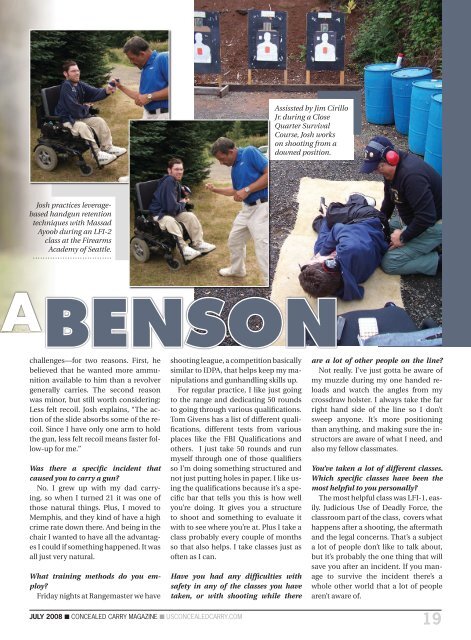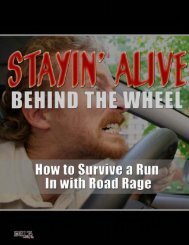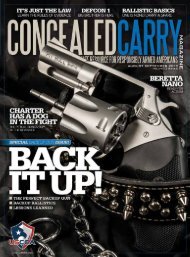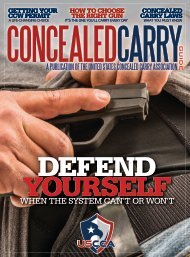Download This Issue - US Concealed Carry
Download This Issue - US Concealed Carry
Download This Issue - US Concealed Carry
Create successful ePaper yourself
Turn your PDF publications into a flip-book with our unique Google optimized e-Paper software.
Assissted by Jim Cirillo<br />
Jr. during a Close<br />
Quarter Survival<br />
Course, Josh works<br />
on shooting from a<br />
downed position.<br />
Josh practices leveragebased<br />
handgun retention<br />
techniques with Massad<br />
Ayoob during an LFI-2<br />
class at the Firearms<br />
Academy of Seattle.<br />
a<br />
Benson<br />
challenges—for two reasons. First, he<br />
believed that he wanted more ammunition<br />
available to him than a revolver<br />
generally carries. The second reason<br />
was minor, but still worth considering:<br />
Less felt recoil. Josh explains, “The action<br />
of the slide absorbs some of the recoil.<br />
Since I have only one arm to hold<br />
the gun, less felt recoil means faster follow-up<br />
for me.”<br />
Was there a specific incident that<br />
caused you to carry a gun?<br />
No. I grew up with my dad carrying,<br />
so when I turned 21 it was one of<br />
those natural things. Plus, I moved to<br />
Memphis, and they kind of have a high<br />
crime rate down there. And being in the<br />
chair I wanted to have all the advantages<br />
I could if something happened. It was<br />
all just very natural.<br />
What training methods do you employ?<br />
Friday nights at Rangemaster we have<br />
shooting league, a competition basically<br />
similar to IDPA, that helps keep my manipulations<br />
and gunhandling skills up.<br />
For regular practice, I like just going<br />
to the range and dedicating 50 rounds<br />
to going through various qualifications.<br />
Tom Givens has a list of different qualifications,<br />
different tests from various<br />
places like the FBI Qualifications and<br />
others. I just take 50 rounds and run<br />
myself through one of those qualifiers<br />
so I’m doing something structured and<br />
not just putting holes in paper. I like using<br />
the qualifications because it’s a specific<br />
bar that tells you this is how well<br />
you’re doing. It gives you a structure<br />
to shoot and something to evaluate it<br />
with to see where you’re at. Plus I take a<br />
class probably every couple of months<br />
so that also helps. I take classes just as<br />
often as I can.<br />
Have you had any difficulties with<br />
safety in any of the classes you have<br />
taken, or with shooting while there<br />
are a lot of other people on the line?<br />
Not really. I’ve just gotta be aware of<br />
my muzzle during my one handed reloads<br />
and watch the angles from my<br />
crossdraw holster. I always take the far<br />
right hand side of the line so I don’t<br />
sweep anyone. It’s more positioning<br />
than anything, and making sure the instructors<br />
are aware of what I need, and<br />
also my fellow classmates.<br />
You’ve taken a lot of different classes.<br />
Which specific classes have been the<br />
most helpful to you personally?<br />
The most helpful class was LFI-1, easily.<br />
Judicious Use of Deadly Force, the<br />
classroom part of the class, covers what<br />
happens after a shooting, the aftermath<br />
and the legal concerns. That’s a subject<br />
a lot of people don’t like to talk about,<br />
but it’s probably the one thing that will<br />
save you after an incident. If you manage<br />
to survive the incident there’s a<br />
whole other world that a lot of people<br />
aren’t aware of.<br />
JULY 2008 n CONCEALED CARRY MAGAZINE n <strong>US</strong>CONCEALEDCARRY.COM<br />
19
















